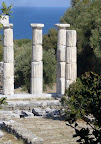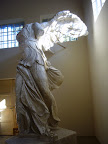Day 1 Day 2
The third day in Samothraki, I took off on a tour around the Eastern edge of the island. The variety of sights within a small space is stunning. I visited an ancient temple site overlooking the ocean, hiked in the mountains to an idyllic, deserted waterfall, and wondered around a black pebbled beach!

 I've written previously about the The Temple of the Great Gods, so I won't add too much. The site is amazingly well preserved considering that Alexander the Great's parents met here. The statue of 'Winged Victory' that is now on display at the Louvre was found here. By the way, France and England, the folks in Greece would like their stuff back.
I've written previously about the The Temple of the Great Gods, so I won't add too much. The site is amazingly well preserved considering that Alexander the Great's parents met here. The statue of 'Winged Victory' that is now on display at the Louvre was found here. By the way, France and England, the folks in Greece would like their stuff back.
A short ride from the temple and into the hills behind Θερμα, brings you into a dense forest on the mountainside. You can hike back in to a series of waterfalls. I only went up to the first one. In the off-season, the area was completely deserted except for a few goats.
A ride east and then south along the eastern coast brought me to a warm beach covered in black pebbles that rolled in and out with the tide.

A short ride from the temple and into the hills behind Θερμα, brings you into a dense forest on the mountainside. You can hike back in to a series of waterfalls. I only went up to the first one. In the off-season, the area was completely deserted except for a few goats.
A ride east and then south along the eastern coast brought me to a warm beach covered in black pebbles that rolled in and out with the tide.
Comments
Post a Comment
Please leave your comments on this topic: